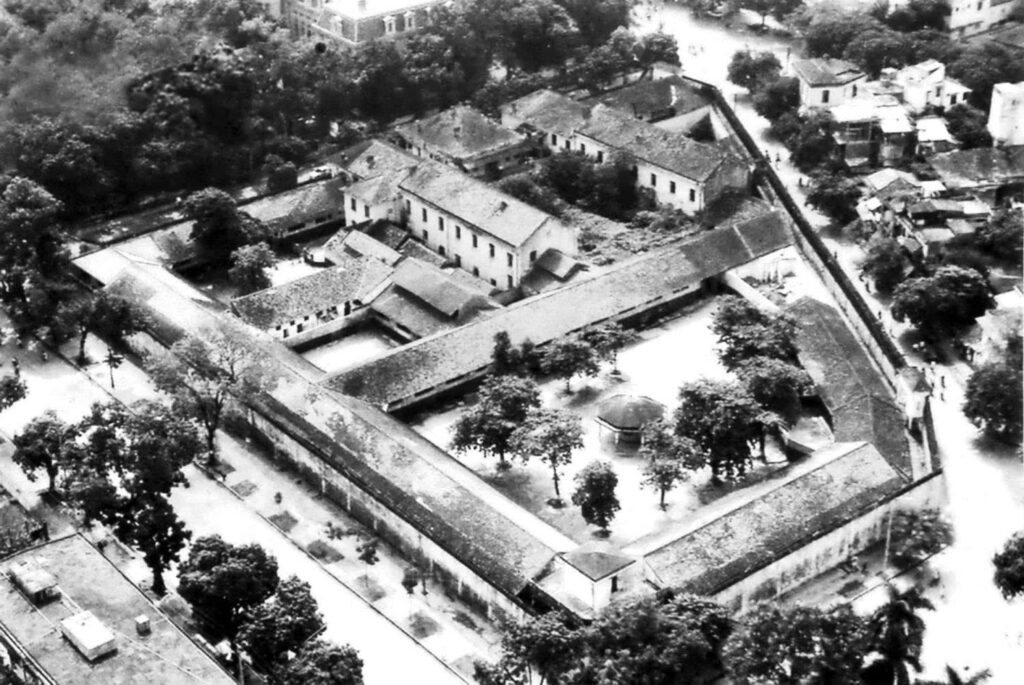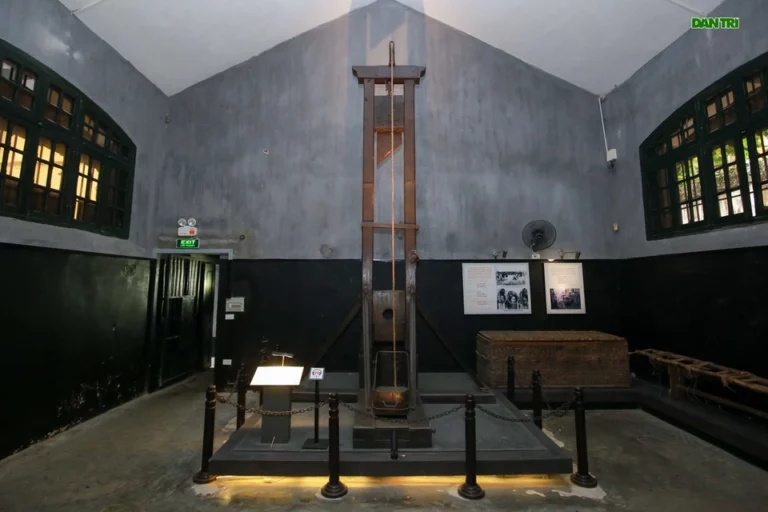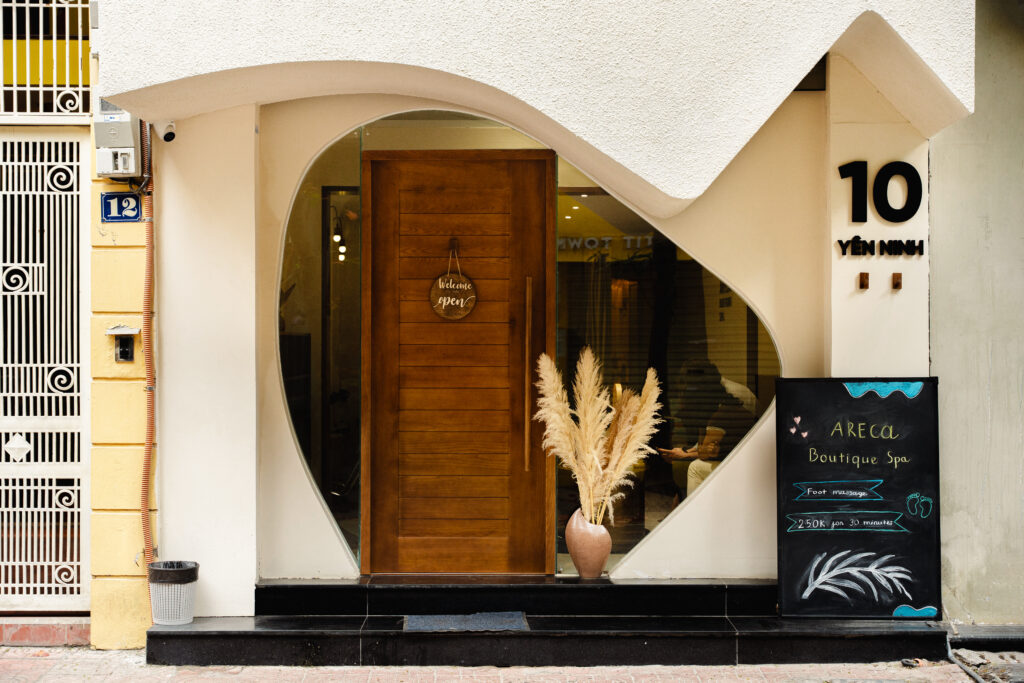Hoa Lo Prison was built by the French colonialists to imprison and torture patriotic soldiers and leaders. After being repurposed, the prison was preserved and restored to become a unique tourist attraction in the capital. Continue reading to discover more stories related to this hellhole.
Where is Hoa Lo Prison?
- Address: 1 Hoa Lo Street, Hoan Kiem District, Hanoi.
Hoa Lo Prison is located on Hoa Lo Street, in the central area of Hoan Kiem District and close to many famous tourist attractions. You can visit this place by various means of transportation, including personal and public vehicles.
If you start from the Hoan Kiem Lake area, you can follow Le Thai To Street towards Hang Trong and go straight through Ba Trieu Street. Next, turn right onto Hai Ba Trung Street, go straight for about 500m and then turn left onto Hoa Lo Street. Hoa Lo Prison will be at number 1 on this street.
In case you want to save on travel costs, the bus is the top choice. You can catch bus number 32, 02, 38 and 41, which have stops near Hoa Lo Prison for convenient travel.

Hoa Lo Prison – An Emotional Journey of Discovery in the Capital
Hoa Lo Prison Opening Hours and Ticket Prices
Hoa Lo Prison is open from 8:00 AM to 5:00 PM every day of the week (including holidays).
The entrance fee is 30,000 VND/person. Certain individuals are eligible for free admission or discounted tickets, specifically:
Free Admission:
- Children under 15 years old.
- People with severe disabilities.
- Members of: the Veterans Association, the National Prison Liaison Committee, and the Resistance Liaison Committee.
- People who have made contributions to the revolution.
50% Discount:
- Students (Student ID required).
- People with disabilities.
- Vietnamese citizens aged 60 and over.
- People with social policy benefits.
In addition, Hoa Lo Prison offers an audio guide service for 50,000 VND/headphone.
Things to Know about Hoa Lo Prison Relic
1. History of Hoa Lo Prison
To counter the Vietnamese people’s resistance movements in the late 19th century, the French colonialists strengthened their repressive apparatus by increasing police forces, completing the court system, and building a network of prisons. In 1896, on the land of Phu Khanh village in Vinh Xuong district, Tho Xuong district, Hanoi, the French built Hoa Lo Prison – one of the largest prisons of the French colonialists in Indochina.
The land of Hoa Lo was once a famous craft village specializing in pottery. However, the French turned it into a place of detention, exile, and deprivation of both physical and mental freedom for thousands of patriotic soldiers and Vietnamese revolutionary activists.

Recreating one of the world’s most notorious prisons
After the North of Vietnam gained independence, the Vietnamese government took over and temporarily used Hoa Lo Prison to detain law violators. However, from August 5, 1964, to March 31, 1973, Hoa Lo Prison was also used to detain American pilots who were shot down during bombing missions in North Vietnam.
In 1993, the Vietnamese government decided to repurpose Hoa Lo Prison to meet the capital’s economic development needs. The southeastern part of the prison was preserved, restored, and embellished to be classified as a historical relic of Hanoi. This Hanoi tourist spot now houses a memorial dedicated to Vietnamese patriotic and revolutionary soldiers who bravely sacrificed their lives in the prison for the nation’s independence and freedom.
2. The Guillotine – A Terror to all Prisoners
Inside Hoa Lo Prison stands a guillotine. This execution device, invented by the French physician Joseph-Ignace Guillotin, was considered a more humane method of execution, replacing medieval forms of punishment like being drawn and quartered.
The guillotine consists of the following main components:
- The base: A wooden platform where the prisoner lies during the execution, their head positioned in a circular hole.
- The frame: A tall metal frame, almost 4 meters high, with grooves guiding the blade’s movement.
- The blade: A steel blade with a slanted edge.
To carry out the execution, the executioner would release a latch and pull a rope, causing the heavy blade to drop swiftly. The force of the falling blade, equivalent to 60kg, would sever the prisoner’s head, which would fall into a metal container below. The body would then be placed in a wicker basket.

The guillotine located inside the prison
3. The “Loyal” Banyan Tree – A Witness to History
As recounted by former political prisoners of Hoa Lo Prison, the banyan tree’s story begins before 1930. Prisoners sentenced to sanitation labor near the courthouse collected wild banyan saplings from the surrounding grassy areas and brought them back to plant in the prison yard. Over time, the banyan tree grew, becoming a cherished companion to generations of political prisoners.
Whenever allowed outside, the political prisoners would gather around the banyan tree, enjoying the fresh air while discussing strategies to resist the oppressive prison regime.
The base of the banyan tree bore witness to their daily lives, listening to their shared stories, dreams, goals, ideals, and the camaraderie of these communists. Moreover, it served as a vital “secret mailbox” for exchanging information and disseminating revolutionary materials.
4. The “Cachot” (Dungeon) – Hell Within Hell
The “cachot” were dungeons, each a mere 4 square meters, with walls painted a somber black. These spaces were devoid of light and fresh air, creating a suffocating, tomb-like atmosphere for the prisoners.
The prisoners’ sleeping platforms were constructed of a special cement, designed so that their heads were positioned lower than their bodies, forcing blood to rush to their heads. The “cachot” were used to punish those who organized resistance, spread revolutionary propaganda, or attempted to escape. Comrade Truong Chinh, for instance, was imprisoned in one after organizing a May Day commemoration within the prison.

The dark and suffocating dungeons at Hoa Lo Prison were compared to tombs
Things to Keep in Mind When Visiting Hoa Lo Prison Relic
- Do not bring flammable substances into the relic site and store personal belongings in designated areas.
- Do not litter or smoke during your visit.
- Do not move any artifacts within the relic site.
- Incense burning and flower offerings are only permitted in the memorial area.
- Consider combining your visit to Hoa Lo Prison with other nearby tourist attractions such as Hoan Kiem Lake, the Temple of Literature, Hanoi Opera House, Thang Long Imperial Citadel, and Hanoi Old Quarter.
Hoa Lo Prison offers a journey of discovery that is both nostalgic and moving, yet also surprisingly fresh. If you have the opportunity to visit the beloved capital, don’t miss out on the fascinating tours within this historic site!
Seeking a peaceful retreat in the heart of Hanoi’s bustling Old Quarter? Look no further than Areca Boutique Spa & Homestay. Our serene sanctuary offers the perfect blend of convenience and tranquility, making it an ideal base for exploring all that Hanoi has to offer.
Unwind and Rejuvenate:
Indulge in our luxurious spa treatments, designed to soothe your body and mind. Our skilled therapists utilize traditional techniques and natural ingredients to create a truly restorative experience.
Rest and Recharge:
Retreat to our cozy homestay accommodations after a day of exploring. Our well-appointed rooms provide a comfortable and inviting space to relax and recharge.
Prime Location:
Nestled in a quiet neighborhood just moments away from the Old Quarter’s vibrant energy, Areca offers the best of both worlds. Easily access iconic landmarks, bustling markets, and diverse culinary experiences, then return to your peaceful haven for a restful night’s sleep.
Experience the Best of Hanoi:
Whether you’re seeking cultural immersion, culinary adventures, or simply a relaxing escape, Areca Boutique Spa & Homestay is your gateway to discovering the rich tapestry of Hanoi.


